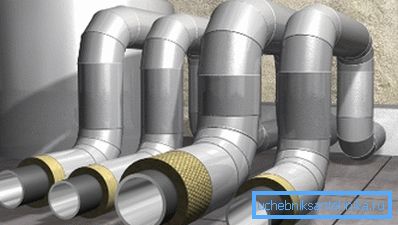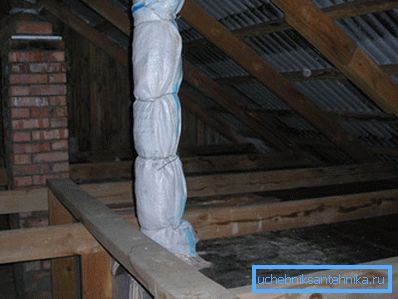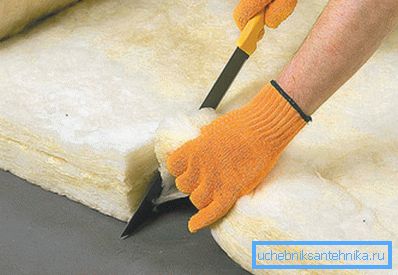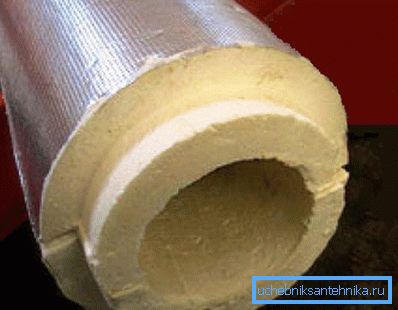Why and how is the insulation of ventilation pipes
Everybody knows why ventilation is necessary - it provides room with fresh air and normalizes the level of humidity. But why make insulation of ventilation pipes, not everyone knows. Next, we will try to answer this question, as well as consider the types of thermal insulation materials and how to install them on the ventilation pipes.

Why warm insulation
Many people doubt whether it is necessary to warm the ventilation pipes, because they do not fully understand the meaning of this procedure. And it is performed for one reason - to prevent condensation.
Condensate inevitably appears on an unheated air duct, which flows down the inner walls, flowing into the ceiling and the main walls.
The consequences of this phenomenon are obvious:
- Damp walls and ceiling;
- Mold appears;
- The structure gradually collapses.

As for the effect of condensate on the ventilation duct, it depends on the material from which the duct is made:
| Galvanized | In case of violation of the protective layer (which is unavoidable when cutting the sheet) with the regular formation of condensate will necessarily suffer |
| PVC pipes | Resistant to moisture |
| Corrugated Aluminum | Also immune to moisture. |
In addition, there is another unpleasant moment associated with the formation of condensate - freezing frost, which can occur outside the heated room, i.e. in the attic. As a result of this, the clearance in the pipe can drop from 100 or even 150 mm to zero in a few cold weeks.
From this we can conclude that it is really necessary to warm the ventilation pipes, and for several reasons at once.

Where to warm the ventilation
Depending on the type of construction of the duct, its insulation can be carried out in different areas:
- If the ventilation pipe is led out through the wall, it must be passed through a heat-insulated sleeve.. Pipe insulation is performed up to the pipe deflector for ventilation.
- In private homes, most often ventilation passes through the attic and goes out through the roof or gables.. In this case, insulate the area of the duct, located in the attic.

Materials
Before warming the ventilation pipes with your own hands, of course, you must choose a heater. Currently, there are quite a few insulation materials on the market, which somewhat complicates the choice. Therefore, first of all it is necessary to determine the requirements for insulation.
In this case, the most priority are the following characteristics of insulation:
- Good thermal insulation qualities are perhaps the most important requirement.
- Fire safety - in case of fire, the pipe should not become a main for the spread of fire.
- Cost - it is desirable that the price of the material was affordable.
Now consider the various heaters, which to some extent meet these requirements.

Mineral wool
One of the most common types of insulation is mineral wool.
Its advantages include the following points:
- Cheapness - any other heater costs more.
- Fireproof.
- Good thermal insulation qualities.
However, this material has some drawbacks:
- Pretty complicated installation.
- Over time, the cotton wool cracks and gaps appear in the insulation.
- When moistening, thermal insulation qualities are lost.
- The need to protect eyes and respiratory system during installation. In addition, mineral wool on the skin causes irritation.
Instructions for insulation of the air duct with mineral wool are as follows:
- The first step is to wrap the pipe with mineral wool.
- Then the heat insulator wraps with aluminum foil. If external warming is carried out, then instead of a foil it is necessary to use a galvanized casing.
Tip! More convenient to install is ready insulation for ventilation pipes, made on the basis of glass wool. The product is a multi-layer corrugated aluminum foil sleeve, between which layers there is a heat-insulating material.

Styrofoam
This insulation is a ready-split shells for pipes made of dense foam.
Among its advantages are such moments as:
- Simplicity and ease of installation.
- Low cost.
- Over time, the material does not lose its insulating properties. Do not affect them and moisture fluctuations.
As for the shortcomings, only two are significant:
- Polyfoam well burns and at the same time emits toxic substances;
- Foam shells can be used only on flat sections of ventilation pipes.
It is extremely simple to carry out the insulation with this material - you need to put on the two halves of the heat insulator on the ventilation pipe and squeeze them in order to fix the thorn-groove connection.
Tip! When weatherizing an air duct of a large extension, the insulator halves are installed with a slight vertical displacement, which ensures their ligation.

Polyurethane foam and polypropylene
These heaters are in many ways similar to foam plastic, however, there are still differences and they consist in the following points:
- Have greater mechanical strength than foam.
- Their cost is higher.
- Fixing the halves is carried out with the help of a bandage, which is most often used knitting wire.
Thus, if the cost of the material does not play a role for you, then it is better to warm the duct with polyurethane foam or polypropylene foam.
Here, perhaps, all the most suitable for these purposes insulation.
Conclusion
Insulation of ventilation pipes in the attic is a mandatory procedure that ensures not only the normal functioning of the system at any time of the year, but also the safety of the entire building. With regard to the choice of insulation, you can give preference to any of the above options.
From the video in this article, you can get more information on this topic.